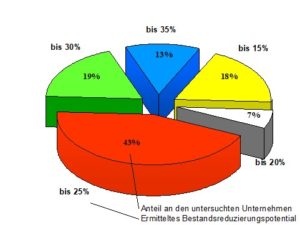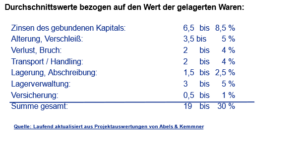Study: The potential for inventory optimization is enormous despite IT
Dipl.-Betriebswirt (FH) Michael Hennen, freelance journalist, Aachen
Stocks are dead capital and cost money. Series and variant manufacturers and wholesalers invest an additional 19 to 30 percent of their average inventory value in warehousing costs each year. As a result, profits can be increased by up to 30 percent of the reduced inventory value when stock levels fall, releasing up to 100 percent of liquid funds. The best starting points for reducing stock levels are strategic stock analyses and the correct setting of parameters in ERP and PPS systems. This is the conclusion of a study by the Herzogenrath-based management consultants Abels & Kemmner.
Inventories in companies have already fallen significantly in recent years due to the introduction of IT systems, but there is still potential for optimization. Although the existing materials management systems support the dispatchers, they rarely offer sufficient analysis functions and optimizations for strategic inventory problems. However, the necessary analytical work cannot usually be carried out by the companies themselves, as day-to-day business does not allow the time. With relatively little effort, a large proportion of stocks and therefore costs can be reduced while at the same time ensuring delivery readiness. This was determined by Abels & Kemmner in an IT-supported study of 34 German series manufacturers and wholesalers.
The procedure
First of all, the items were ranked according to importance and predictability. The criteria used were, for example, the proportion of sales, the stock level, the service level, but also examinations of trends, seasonality and similar. This information was incorporated into an ABC-XYZ analysis and allowed the articles to be structured and grouped accordingly. Suitable replenishment strategies and the respective replenishment parameters were determined for each article group. The expected stock levels were then simulated.
Examination result
Taking into account the supply chain optimization potential identified, Abels & Kemmner determined that 82 percent of the companies surveyed had at least 15 percent savings potential, and 32 percent could even save more than 25 percent. The largest cluster with 43 percent of companies can save between 20 and 25 percent.
Causes of the optimization potential
The reasons for the existence of existing optimization potential are that companies either rely on the parameters of the systems used or do not have the necessary know-how or simply do not invest the time or money required to initiate strategic optimization measures. The V2K problem has also contributed to this, as many new systems have been introduced that are still not optimized today. As it turns out, however, savings are being made in the wrong place.
The most common defects
The survey revealed the most frequent deficiencies in the following areas:
- Parameters preset by software houses were adopted without company-specific verification
- If parameter settings were made deliberately, they were based on data collected more than a year ago
- The calculation methods used were often not suitable for the stock issue behavior of the items concerned
- In some cases, only the simplest inventory planning procedures exist in the ERP systems (see also box)
- Important uncertainty factors in material inventory planning (excess consumption, delivery delays or underdelivery) would not be taken into account
Conclusion
By developing a company-specific scheduling strategy and setting the right parameters in ERP and PPS systems, it is possible to increase delivery readiness and ultimately sales, reduce costs and strengthen competitiveness. At the same time, market-oriented corrections can be made to streamline the product range to what is actually necessary.
View
Based on the identified optimization potential, Abels & Kemmner developed the DISKOVER 4.0 add-on tool, which enables automatic parameter optimization in the ERP system. The program is currently being tested at two pilot companies, Herth+Buss (SAP/R3) and Rudolph Küchentechnik (FAMAC). Interfaces to other ERP/PPS systems are to be implemented in the near future.
As an active component, the system supports operational and strategic scheduling. Due to the aforementioned problems of normal distribution-based calculation models, innovative (distribution-free) calculation methods were developed for both demand forecasting and safety stock determination. The optimum process variants and parameters can be selected for each article using a targeted article-specific analysis. A controlling instrument enables the dispatcher to identify articles (groups) that can be improved by means of key figures and to select them for the introduction of appropriate measures.

